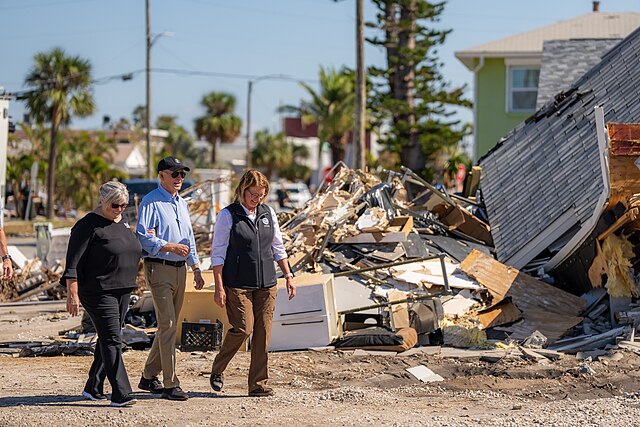I had been preparing for the worst, but I was stunned to see that the island was mostly intact.
In early October of 2024, I watched from afar as Hurricane Milton slammed into Florida. While news of these catastrophic events have become commonplace in recent years, it’s personal for me. I grew up traveling back and forth between my home in New York and my grandparents’ in Southwestern Florida. When we heard the word “hurricane,” it usually meant adopting a certain level of caution, but never that much, as they generally tended to steer mostly clear of the area where my grandparents lived. Of course, there were a few exceptions, like Hurricane Ian in 2022 which got pretty close; but never in my life have I felt as on-edge as in 2024, when first Hurricane Helene grazed Southwestern Florida in September 2024, and then less than two weeks later, Hurricane Milton was due to hit it head-on.
I was lucky, as I was watching from a great distance away. I wasn’t there; I couldn’t feel what people like my grandparents were feeling. Still, my heart sank as I saw the hurricane set on a direct collision course for a place I call home. Yet when the dust had settled, the state sent a small plane to take photos of the damage from above. I breathed a huge sigh of relief. From what I could see, we would be alright.
I only got the chance to go down and see the damage for myself in late February to early March 2025, by which time a lot of the reconstruction work had already been done. This, though, became a subject of my curiosity as I prepared to ask people what had happened. In Boca Grande, a small town on a barrier island off the west coast of Florida, I sought to evaluate with my own eyes the physical, financial, and mental toll that these hurricanes actually take on inhabitants, rather than just seeing it on the news.
“It’s miraculous,” a local said when I asked him about how the island town recovered, “first we had Helene which dumped a lot of sand in the streets, and then, when most of that had been cleared out, well then we had Milton. Think of about this much sand, practically up to your waist. That was downtown for a good while.”
To me, downtown looked the same, but according to him, this was a recent development. “I know it looks alright now,” he continued, “but for a few weeks, you practically couldn’t get anywhere. We had sand removal teams working around the clock.”
That was something I continued hearing from everyone I spoke to; the sand was everywhere, and it was a pain to move out of the way. Though largely complete, the sand-displacement operation had still not yet been fully concluded. Even as late as February or March, nearly five months later, I could still see piles of sand scattered around the island, still waiting to be cleared.
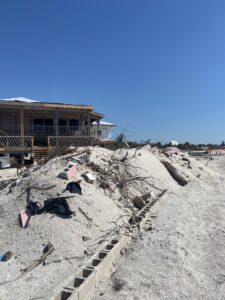
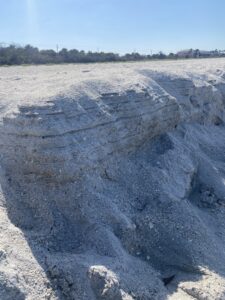
Left – Excess sand near a damaged house still yet to be moved.
Right – Mesa-like structures on the beach formed by sand pushed up by large waves.
The sand had been shaped by the storm surge, which is an excess of water pushed ashore by incredible force due to hurricane winds. With already higher-than-usual sea levels due to ongoing climate change, the risk for low-lying coastal places like Southwestern Florida continues to rise dramatically. Hurricane Milton was abnormal in its power, a sign of climate change’s worsening effects. Boca Grande was lucky in that it was mostly grazed rather than directly hit, but the damage was still tremendous.
“They spent more than 30 million dollars fixing that beach club,” someone noted aloud as we drove past a beach club owned by the island’s main inn. Its condition appeared fantastic as far as I could tell, yet while I saw no difference in the before versus the after, I knew it was because I had not seen the “during.” For those I spoke to, it was a no-brainer to get everything fixed as quickly as possible. However, that brings to light other major issues. With the increase in hurricane severity and frequency given accelerating climate change, can places like Boca Grande afford to keep spending so much money to fix everything every time a hurricane hits or even just grazes them? What happens to the places we know for a fact cannot afford to fix everything? What if storms of Milton’s power become a yearly occurrence? Will Southwestern Florida then be habitable at all?
The US Global Climate Change Research Program has confirmed that the intensity and frequency of these hurricanes are in fact expected to increase, while the National Oceanic and Atmospheric Administration (NOAA) Science Council reports that future projections show possible increased numbers of Category 4 & 5 hurricanes, with even higher wind speeds. While Milton itself reached Category 5, it was only for about a minute, falling to a Category 3 when it made landfall. This means, though, that all of this damage was caused by a mid-level hurricane, whereas hurricanes are only expected to increase in power, as are their impacts.

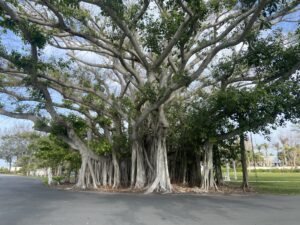
Left – A seawall smashed by storm surge left in disrepair.
Right – A banyan tree with most of its top-most leaves still missing.
Despite most of the reconstruction having been completed, it still felt crazy to walk around Boca Grande even so long after Hurricane Milton hit. Places I knew so well as a kid just felt a little… off. As I noted before, it doesn’t nearly compare to what people who actually fully live there have had to go through. The closest I could get to understanding their experience was to talk to them, but that only got me so far. A number of buildings were still damaged, some trees still bare, but life moved on, even with the constant reminders of what had happened, along with what could still happen in the future.
“That over there is my friend’s house,” someone said to me, pointing down the street, “it looks fine now, but when Milton hit, her entire living room was just wiped out. Think of if the whole ocean took one swipe at your house and threw all of your furniture on the beach and on the street. Someone else I know further down had their boat pushed onto the street as well.”
Boca Grande (and Southwestern Florida as a whole) is fortunate enough to be very wealthy. The average household income sits at about $215,253 USD per year, and as a tourism hotspot, the community rakes in a lot of money from the many visitors that come to see its beautiful cozy town and its spectacular beaches on the Gulf of Mexico. You don’t need to go far to find far less fortunate areas that are far more vulnerable to these events due to their lack of funds to undertake full reconstruction. Places like North Carolina, hit hard by Hurricane Helene, only have an average household income of about $69,904 USD per year, or even lower if considering the rural areas that were hit the hardest. Yet affected areas in the United States have the support of a wealthy government, mostly through the Federal Emergency Management Agency (FEMA). In Cuba, even closer to Boca Grande and also in the path of destruction of hurricanes, most households make only about $9,324 USD per year. Even while accounting for things like differences in purchasing power, dealing with damage on this scale in less fortunate areas is far more difficult, and it wasn’t easy to begin with even in wealthy Boca Grande.
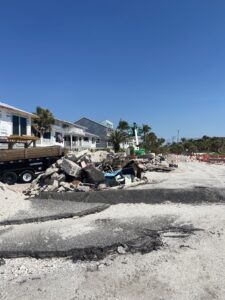
A pile of rubble in front of a home still being repaired.
None of this is to say that anyone coping with the aftermath of hurricanes “has it easier” than anyone else, but it sure removes some financial and mental stress when reconstruction efforts do not threaten to bankrupt people and leave them without access to basic essentials. Boca Grande’s recovery efforts were incredibly effective and monumental in scale, requiring tens of millions of dollars of investment. Not every municipality or region has the capacity to invest so much. These storms are only set to get worse, meaning that the repair bill is only going to get more substantial, and paying it, a more common occurrence.
The person giving me a ride off the island gave me one last bit of insight as I was leaving. She’d sheltered up north in Massachusetts when Hurricane Milton hit Boca Grande, and like me, watched from afar.
“Imagine everything you see around here with sand, broken windows, and damaged roofs,” she said, “and all this from a Category 3. The people I was with in Massachusetts didn’t really fully understand that even a Category 3 is really powerful. Milton’s storm surge was so strong it [the water] literally went all the way across the island from one shore to the other. Imagine what would’ve happened if that was a Category 5.”
Indeed, that was what I had been thinking when I watched the news in October, and what I was thinking at that moment as I left Boca Grande in March. Climate change isn’t just some abstract, far away ‘thing’ that’s going to mess up the future, it’s already wrecking the present. Rising sea levels, and more intense and more frequent storms are already threatening people, animals, and vegetation, and the worst is yet to come. Taking little action to mitigate climate change will result in big costs today and down the road. The people I saw in Boca Grande know this because they live this reality. We need to see the issue like they do, and understand that this new normal is anything but normal.
Edited by Jamie Silverman
Oliver “Ollie” Scott-Hansen is an undergraduate student at McGill University studying history and Russian language, hailing from just outside New York City, yet maintaining similarly strong ties to his familial heritage in north and central Italy. He joined the Catalyst team in Fall 2024 as a staff writer, something he enjoys doing as a hobby as well. With a particularly vested interest in Eastern Europe, the post-USSR world, and the Russo-Ukrainian war, coupled with his various connections throughout the global international relations space, Ollie reports on issues throughout the world that mostly center around key geopolitical developments in contentious places mostly involving war/conflict, and domestic affairs within the United States. He has experience mainly reporting from Telegram, carefully analyzing the Russian Invasion of Ukraine through his updates forum there, but also spends considerable amounts of his free time glued to maps and statistics trying to make sense of the crazy world that surrounds our day-to-day lives.

